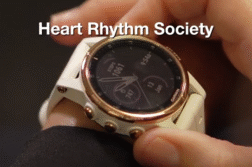DETROIT, Mich. (Ivanhoe Newswire) – More than 17,000 people die every year from an aortic aneurysm – a balloon-like bulge in the aorta. The aorta is the artery that carries blood from the heart through the chest to the rest of the body. If the aneurysm ruptures, a patient could die, and many have no symptoms prior to death. But now, researchers have created a new tracking method that could help patients who are diagnosed before tragedy strikes.
Doctors at the University of Michigan Health detected Dave Gordon’s aortic aneurysm over three years ago and monitored its growth using a new 3D measuring system called vascular deformation mapping, or VDM.
“My surgeon, then, basically advised me and said, ‘Okay, it’s gotten to the size that we probably need to operate on this and fix it.’,” Dave recalls.
Director of Aortic and Structural Heart Imaging at University of Michigan Health, Dr. Nicholas Burris, explains, “Ultimately, what we’re trying to figure out with this technique, in the long term, is who really needs that surgery and who probably doesn’t.”
An aortic aneurysm is a balloon-like growth in the artery that can rupture if it grows too large. Without VDM, the size is measured by human raters – people who look for changes by comparing flat CT images, taken months apart.
Dr. Burris adds, “You can have a hard time visually seeing the difference between the two scans, and then, ultimately, making a measurement.”
But with VDM, several high-definition images are aligned to create a 3D data set. It calculates growth with greater accuracy, and it may be a better way to determine if and when surgery is needed. Aortic aneurysms are often asymptomatic. Most, like Dave’s, are found through unrelated medical tests and surgically repaired when necessary. His treatment led to more smiles with friends for years to come.
“We want to be able to say your aorta has not changed at all with a very high degree of confidence,” Dr. Burris emphasizes.
Scans from 50 patients were used in the study. The researchers are hoping to get FDA approval for VDM within the next two years.
Contributors to this news report include: Hillary Rubin, Producer; Thad Sablboro, Videographer; Roque Correa, Editor.
To receive a free weekly e-mail on medical breakthroughs from Ivanhoe, sign up at: http://www.ivanhoe.com/ftk
Sources: American Heart Association and University of Michigan Department of Radiology
MEDICAL BREAKTHROUGHS
RESEARCH SUMMARY
TOPIC: STOPPING AORTIC ANEURYSM WITH HEART MAPPING
REPORT: MB #5060
BACKGROUND: Aortic aneurysms can either dissect or rupture. If the aneurysm dissects that means the force of blood pumping split the layers of the artery wall allowing blood to spill through them. If the aneurysm ruptures, then it has just burst completely and is now bleeding inside that person’s body. The U.S. Preventive Task Force has asked men age 65 to 75 that have smoked to get an ultrasound screening of abdominal aortic aneurysms. Some symptoms that aortic aneurysms present are tenderness or pain in the chest area, shortness of breath and coughing. You should seek medical help if you experience sharp, sudden pain that radiates downward, difficulty breathing, and pain in your chest, jaw, neck, and arms. Other risk factors for aortic aneurysms include high blood pressure or cholesterol, atherosclerosis, and any unhealthy behaviors such as smoking.
(Source: https://www.cdc.gov/heartdisease/aortic_aneurysm.htm, https://www.mayoclinic.org/diseases-conditions/thoracic-aortic-aneurysm/symptoms-causes)
DIAGNOSING: Aortic aneurysms are normally found during a physical exam that is being done for a different reason or during a routine medical test. If you think you are at risk or have an aortic aneurysm the doctors will look at your medical history and will confirm the diagnosis with imaging tests. Some of these tests include abdominal ultrasound, abdominal CT scan, or abdominal MRI. Echocardiogram, which is a test that uses sound waves to capture real-time images of your heart and the aorta. This test shows chambers and valves of your heart and how they are working with each other. In some cases, there is another test that is called a transesophageal echocardiogram that allows the viewer to see a better image of the aorta. Being male and smoking increase your risk of developing an aortic aneurysm. For screening, doctors recommend that males ages 65 to 75 who have smoked should have at least one screening done using an abdominal ultrasound test. For males 65 to 75 that have never smoked the doctors will decide if a screening test is needed based on other factors. Every year more than 100,000 people are diagnosed with an abdominal aortic aneurysm. A ruptured aneurysm is the 15th leading cause of death in the country and the 10th leading cause of death in men.
(Source: https://www.mayoclinic.org/diseases-conditions/abdominal-aortic-aneurysm/diagnosis-treatment, https://vascular.org/patients-and-referring-physicians/conditions/abdominal-aortic-aneurysm) .
NEW TECHNOLOGY: After you have been diagnosed the doctors will either monitor, medicate, or perform surgery for the condition. If they decide that monitoring is the best decision for your case, that means the aneurysm is not life threatening yet, but they will keep doing imaging tests to check it and the patient will have regular follow up exams for at least six moths after the diagnosis. If they decide to medicate that means that they will most likely put you on some type of medication to lower your blood pressure or cholesterol, like Beta blockers or statins. If surgery is required, they will perform it based on where your aneurysm is and depending on the type of aneurysm.
(Source: https://www.mayoclinic.org/diseases-conditions/thoracic-aortic-aneurysm/diagnosis-treatment)
FOR MORE INFORMATION ON THIS REPORT, PLEASE CONTACT:
Noah Fromson
If this story or any other Ivanhoe story has impacted your life or prompted you or someone you know to seek or change treatments, please let us know by contacting Marjorie Bekaert Thomas at mthomas@ivanhoe.com




